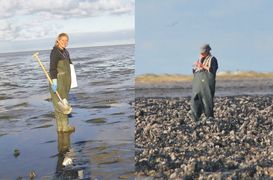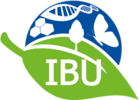Contact
Institute of Biology and Environmental Science (IBU)
eMail achim.wehrmann@uol.de
C2
C2 Neobiota in the Wadden Sea - Pacific oysters and their effects on the biotic environment

Ms Alexandra Markert
IBR PhD Candidate
| Contact details: | SENCKENBERG am Meer, AG Bioinvasion, 26382 WHV |
|---|---|
| Email: | mar-k-art@gmx.de |
Supervisors:
PI: Achim Wehrmann, Co-PIs: Gabriele Gerlach, Peter Schupp, Oliver Zielinski
Projects and Research:
Increasing numbers of marine species have been transported across natural barriers in recent times. When they become established, the non-indigenous species may threaten native biodiversity as well as ecosystem functions of the region. However, introduced ´ecosystem engineers´ may also create habitat structures which locally can enhance biological diversity. As an ecosystem engineer, the Pacific oyster Crassostrea gigas is an organism that directly or indirectly modulates the availability of resources to other species. Major impact is assumed to originate in high abundances of the ecosystem engineer, influencing vast areas over a long period.
First Pacific oysters in the Central Wadden Sea (Lower Saxony) were recorded in 1998, most likely originating from eastward larval drift via Texel. The initial colonization of the tidal flats occurred predominantly on intertidal beds of the blue mussel Mytilus edulis, which provide secondary hard substrate for the settlement of C. gigas larvae. M. edulis is an ecosystem engineer in the sediment dominated tidal flats of the Wadden Sea. Compared to ambient tidal flats, Mytilus beds are ´islands of biodiversity´, providing shelter and offering food resources to epibenthic organisms. Biodeposits enrich the sediments with organic matter, enhancing infaunal diversity. Additionally, Mytilus-beds are an important food resource for many fish species, a variety of bird species and humans.
Occupying the same habitat, blue mussels and oysters are facing competition for space and food. Massive spatfalls resulted in an exponential increase of Pacific oysters. The process of multiple larval settlements on conspecific oysters leads to the creation of rigid reef-like structures. In contrast to flexible three-dimensional structures of Mytilus beds, Crassostrea reefs constitute a new biogenic structure in the Wadden Sea. C. gigas may influence habitat features in a similar way like M. edulis. The topography and structural complexity of a biogenic habitat affects its ecological role and differences in ecosystem engineering may alter the resident biocoenosis. The substantial habitat change from intertidal Mytilus beds to Crassostrea reefs may continuously promote associated organisms as a first investigation at an initial stage of the bioinvasion in 2005 revealed a high biodiversity in oyster dominated areas (Markert et al. 2010). High numbers of crabs attracted curlews to use dense Crassostrea reefs as a feeding site and oystercatchers preferred oysters over mussels (Markert et al. 2013). The bioinvasion of the Asian brush crab Hemigrapsus takanoi (Markert et al. 2014) implies the assumption that invader-invader mutualism facilitates secondary invasions at Crassostrea reefs.
Annual data on the population dynamic of oysters and mussels (2003-2013), on the macrofaunal species composition (2005-2013) and on the population dynamic of H. takanoi (2008-2013) was assessed in the course of various projects.
Long-term data analyses will enhance the understanding of the effects of the non-indigenous ecosystem engineer C. gigas on species assemblage, biodiversity and ecosystem function.
- Will the non-indigenous oyster suppress the native blue mussel?
- How is the response of the associated biota to the development of Crassostrea reefs?
- Are there shifts in functional diversity of the associated biota of Crassostrea reefs over time?
- Will there be community effects even in reef-adjacent tidal flats?
- What is the role of Crassostrea reefs for the fish community?
- Is the invasion of the Asian brush crab related to the establishment of Crassostrea reefs?
Peer reviewed articles
Markert A, Raupach MJ, Segelken-Voigt A, Wehrmann A (2014) Molecular identification and morphological characteristics of native and invasive Asian brush-clawed crabs from Japanese and German coasts: Hemigrapsus penicillatus (De Haan, 1835) versus Hemigrapsus takanoi Asakura & Watanabe 2005 (Crustacea: Brachyura). Organisms, Diversity and Evolution 14 (4): 369-382. DOI 10.1007/s13127-014-0176-4
Markert A, Esser W, Frank D, Wehrmann A, Exo KM (2013) Habitat change by the formation of alien Crassostrea-reefs in the Wadden Sea and its role as feeding sites for waterbirds. Estuarine, Coastal and Shelf Science 131: 41-51. DOI 10.1016/j.ecss.2013.08.003
Markert A, Wehrmann A, Kröncke I (2010) Recently established Crassostrea-reefs versus native Mytilus-beds: differences in ecosystem engineering affects the macrofaunal communities (Wadden Sea of Lower Saxony, southern German Bight). Biol Invasions 12 (1):15–32. DOI 10.1007/s10530-009-9425-4
CV
2006-2015 SENCKENBERG am Meer (Wilhelmshaven, Germany): Research assistant of several projects
2006 Diploma degree biology
2004 Rhodes University (Grahamstown, Südafrika)
2001-2002 Universidad de València (València, Spanien)
1997-2006 Freie Universität Berlin (Berlin, Germany)
1992-2002 Freelancer cartography (Berlin, Germany)
1990-1992 Employee cartography( Frankfurt a.M., Germany)
1989-1990 Equine groom (New York, USA)
1987-1989 Employee cartography (München, Germany)
1987 Degree: Graduate Engineer Cartography
1982-1987 Fachhochschule München (München, Germany)
1982 Abitur (Großburgwedel, Germany)



